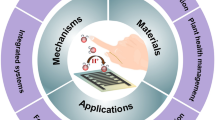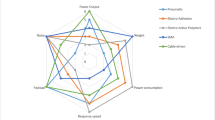Abstract
This paper presents a high-precision intelligent flexible robot grasping front-end with an integrated capacitive tactile sensor array and a conditioning chip. The capacitive tactile sensor is the primary part of the front-end, it determines the overall performance. The micro-needle array sandwich structure in the tactile sensor increases the repeatability and stability, and ensures the sensitivity. The assembled sensor exhibits a saturation at 10.53 N (421 kPa) with a sensitivity of 1.9%/kPa. Furthermore, a conditioning chip is utilized in a custom readout interface to achieve better performance by reducing signal attenuation, and to increase the compatibility of the front-end. The chip is optimized for the parasitic shunt capacitance in the capacitor array. A dual bidirectional charge-discharge conversion method and a two-port detection method are matched to achieve the goal of reducing the shunting influence, and attenuating the offset voltage or the noise input effects. A prototype of the interface has been fabricated using 180-nm CMOS technology. Sensor with the value of 0.5 pF shunted by capacitors of 47 pF has been detected with an error of 1% within 100 μs.
摘要
创新点
本文提出了一种应用于高精机器人应用的高灵敏度的柔性抓握前端。 该前端集成了电容传感器和调理芯片。 其中, 电容传感器是柔性抓握前端的主体, 它决定了整体的性能。 夹杂在两电容极板间的微针阵列结构提升了器件的可重复性、稳定性和灵敏度。 键合后的器件在10.53N(421kPa)压力输入时呈现饱和, 灵敏度为1.9%/kPa。 同时, 前端中搭配了专用的调理芯片以达到更好的性能和更高的集成度。 芯片针对电容阵列中不可消除的寄生电容效应做了专门处理。 本文中将双模双向充-放电方法和两端检测方式匹配, 来实现寄生电容的消减。 该方案对输入失调电压和输入噪声电压的消减也十分有效。 芯片在180 nm CMOS工艺条件下流片验证。测试结果显示, 0.5pF的电容在47pF寄生电容的影响下误差仅为1%。
Similar content being viewed by others
References
Khasnobish A, Singh G, Jati A. Object-shape recognition and 3D reconstruction from tactile sensor images. Med Biol Eng Comput, 2014, 52: 353–362
Decherchi S, Gastaldo P. Tactile-data classification of contact materials using computational intelligence. IEEE Trans Robotics, 2011, 27: 635–639
Teshigawara S, Tadakuma K. High sensitivity initial slip sensor for dexterous grasp. In: Proceedings of IEEE International Conference on Robotics and Automation, Anchorage, 2010. 4867–4872
Haris M, Qu H. A CMOS-MEMS nano-newton force sensor for biomedical applications. In: Proceedings of Nano/Micro Engineered and Molecular Systems, Xiamen, 2010. 177–181
Noda K, Shimoyama I. A shear stress sensing for robot hands-orthogonal arrayed piezoresistive cantilevers standing in elastic material. In: Proceedings of Haptic Interfaces for Virtual Environment and Teleoperator Systems, Alexandria, 2006. 63–66
Kim K, Lee K R, Kim Y K. 3-axes flexible tactile sensor fabricated by Si micromachining and packaging technology. In: Proceedings of Micro Electro Mechanical Systems, Istanbul, 2006. 678–681
Yang Y J, Cheng M Y, Chang W Y. An integrated flexible temperature and tactile sensing array using PI-copper films. Sensors Actuat A: Phys, 2008, 143: 143–153
Hu X H, Zhang X, Liu M, et al. A flexible capacitive tactile sensor array with micro structure for robotic application. Sci China Inf Sci, 2014, 57: 120204
Li P, Liu M, Zhang X, et al. A low-complexity ECG processing algorithm based on the Haar wavelet transform for portable health-care devices. Sci China Inf Sci, 2014, 57: 122303
Han J Q, Zhang X, Pei W H, et al. A compact neural recording interface based on silicon microelectrode. Sci China Tech Sci, 2013, 56: 2808–2813
da-Rocha J G V, da-Rocha P F A, Lanceros-Mendez S. Capacitive sensor for three-axis force measurements and its readout electronics. IEEE Trans Instrum Meas, 2009, 58: 2830–2836
Cheng M Y, Lin C L, Yang Y J. Tactile and shear stress sensing array using capacitive mechanisms with floating electrodes. In: Proceedings of IEEE 23rd International Conference on Micro Electro Mechanical Systems, Wanchai, 2010. 228–231
Peng P, Rajamani R, Erdman A G. Flexible tactile sensor for tissue elasticity measurements. J Microelectromech Syst, 2009, 18: 1226–1233
Hoshi T, Shinoda H. Robot skin based on touch-area-sensitive tactile element. In: Proceedings of the 2006 IEEE International Conference on Robotics and Automation, Florida, 2006. 3463–3468
Xu Z, Ming L, Bo W, et al. A wide measurement range and fast update rate integrated interface for capacitive sensors array. IEEE Trans Circuits Syst I: Regular Papers, 2014, 61: 2–11
Lei K F, Lee K, Lee M. Development of a flexible PDMS capacitive pressure sensor for plantar pressure measurement. Microelectron Eng, 2012, 99: 1–5
Pritchard E, Mahfouz M, Evans Iii B, et al. Flexible capacitive sensors for high resolution pressure measurement. In: Proceedings of IEEE Sensors, Lecce, 2008. 1484–1487
Lee H K, Jaehoon C, Chang S I, et al. Normal and shear force measurement using a flexible polymer tactile sensor with embedded multiple capacitors. Microelectromech Syst, 2008, 17: 934–942
Author information
Authors and Affiliations
Corresponding authors
Rights and permissions
About this article
Cite this article
Hu, X., Zhang, X., Liu, M. et al. High precision intelligent flexible grasping front-end with CMOS interface for robots application. Sci. China Inf. Sci. 59, 32203 (2016). https://doi.org/10.1007/s11432-015-5358-y
Received:
Accepted:
Published:
DOI: https://doi.org/10.1007/s11432-015-5358-y




